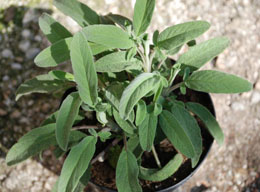Pineapple sage (Salvia elegans), well-known for its pineapple-scented leaves, is commonly grown in flower gardens and herbal gardens. For some more valuable information about this multipurpose plant, read this Buzzle article.

Pineapple sage belongs to the Lamiaceae family of the order Lamiales. It is a herbaceous, semi-woody, subshrub, which grows about 1-1.5 meters in height, and spreads about 0.5-1 meter in diameter. The herb is named so, as the foliage exhibits a typical fragrance similar to a pineapple. Though pineapple sage is native to the high altitudes of Mexico, it is distributed all over the world.
Description
The stem is square-shaped; lateral branches develop in opposite sides of the main stem. The leaves are pale, yellowish-green, hairy, with serrated margins and arranged in opposite phyllotaxy. Pineapple sage blooms in late summer or early autumn based on the variety and growing conditions. The flowers are ruby-red and tubular with two characteristic lips. The inflorescence type is a terminal spike.
Propagation
Pineapple sage propagation can be done by seeds. Nevertheless, cultivation of the plant rarely produces viable seeds. A more reliable method of propagation is stem cutting obtained during spring season. For preparing stem cuttings, cut the branches of about 4-5 inch in length by using a sharp blade. Remove the matured leaves from the base of the branches, leaving those in the tip portion. Plant these cuttings in pots by using fertile, organic soils. As the cuttings develop the root system, they can be transplanted as per your convenience.
In the Garden
It is an attractive ornamental plant, usually grown for designing the landscapes. The pineapple-scented leaves attract butterflies and hummingbirds. Considering this, it is mostly grown in butterfly gardens. Many hobbyists prefer to grow these plants at the center of the flower beds or as a background shrub in gardens. For those with limited land, and/or unfavorable soil conditions, the plant can be grown even in pots and containers.
Pineapple sage grows best in well-drained soil. The plantation site should receive optimum sunlight. For better growth of these plants, regular sunlight and watering should be done. As it cannot tolerate extreme cold conditions, it is necessary to protect the plants from frost. In cold regions, it is grown as annuals in the pots and containers. While the plants are left outdoors during the summer season, they are kept indoors during the winter months.
A Multipurpose Herb
It is often considered as a multipurpose herb due to its wide applications. It is used extensively as a culinary herb in flavoring salads, ice creams, puddings, chicken recipes, jellies, and sauces. Both the foliage and flowers are extensively used for the preparation of herbal tea and cold summer drinks. For preparing the tea, harvest the old leaves and put in the boiling water. Cover with the lid, and allow to stand for about five minutes. Strain the leaves and drink. For an additional flavor, honey and lemon juice can also be added.
Pineapple sage is used for therapeutic purposes. It has been used in Mexican traditional medicine since a long time. Some of the health conditions that are known to be treated by using this herb are, anxiety, digestion disorders, heartburn, and nervous system problems. It is also used as a general tonic to improve overall health.






 Pineapple sage belongs to the Lamiaceae family of the order Lamiales. It is a herbaceous, semi-woody, subshrub, which grows about 1-1.5 meters in height, and spreads about 0.5-1 meter in diameter. The herb is named so, as the foliage exhibits a typical fragrance similar to a pineapple. Though pineapple sage is native to the high altitudes of Mexico, it is distributed all over the world.
Pineapple sage belongs to the Lamiaceae family of the order Lamiales. It is a herbaceous, semi-woody, subshrub, which grows about 1-1.5 meters in height, and spreads about 0.5-1 meter in diameter. The herb is named so, as the foliage exhibits a typical fragrance similar to a pineapple. Though pineapple sage is native to the high altitudes of Mexico, it is distributed all over the world.